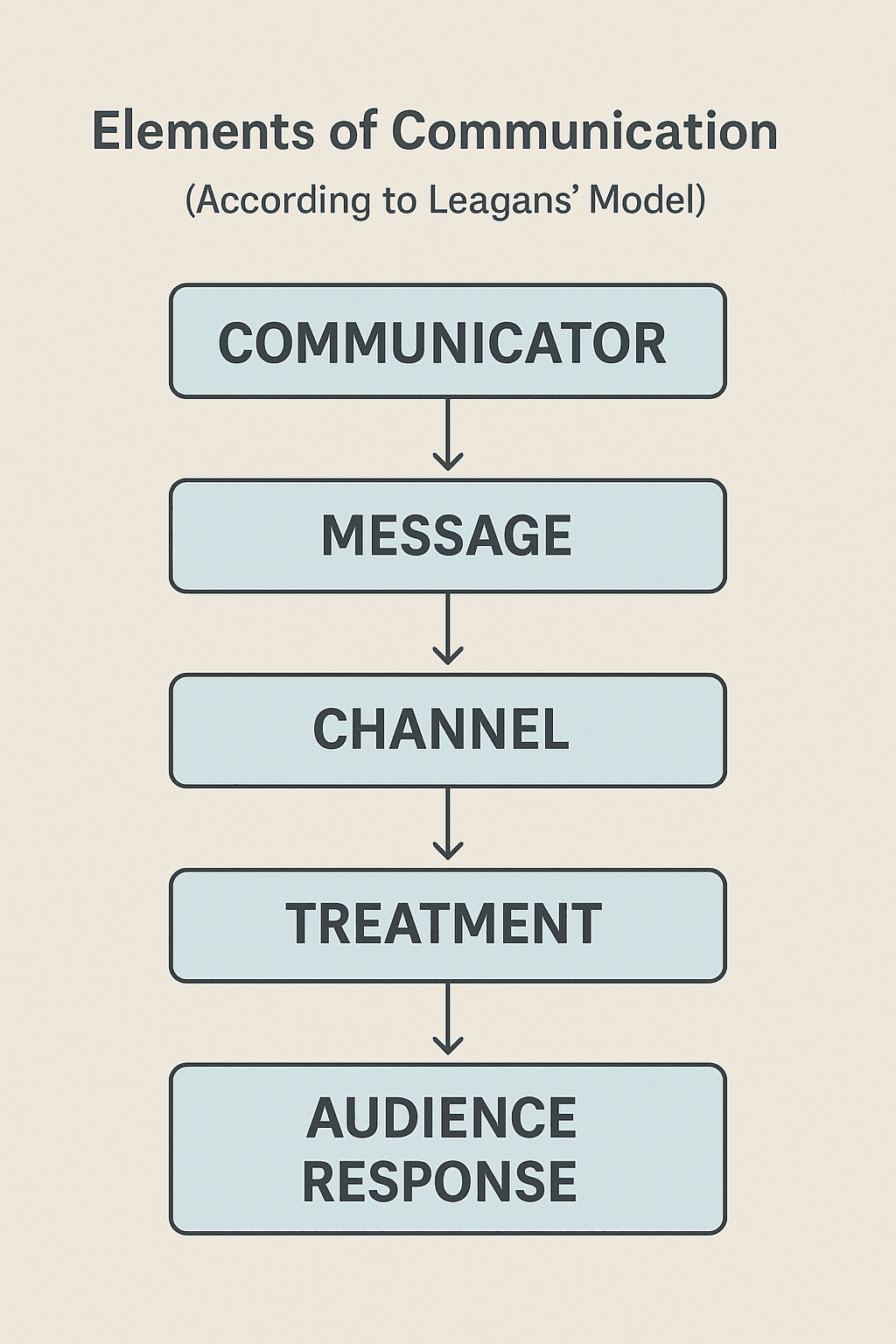Elements of Communication
(According to Leagans’ Model):
- Communicator
- Message
- Channel
- Treatment
- Audience
- Audience Response

- Communicator
- The initiator or sender of the message.
- In Extension: a communicator may be a village-level worker, BDO, SMS, scientist, etc.
- Source of knowledge: research institutes, universities, projects.
- Extension agents carry messages from research to farmers.
Credibility:
- Means: Trustworthiness and competence.
- Progressive villages: Scientist > Radio > Progressive Farmer > Extension Agency > Demonstration.
- Non-progressive villages: Demonstration > Progressive Farmer > Scientist > Extension Agency > Radio.
Attitude of Source: Should be favorable towards self, audience, and content.
Fidelity: Refers to faithful performance of communication. Increases by skill, not just attitude.
Key Communicator: A person sought for information and advice.
- Identified using:
- Sociometric Method: Best method. Members nominate people they go to for advice. Result: Sociogram.
- Self-designating Method: Individuals assess themselves.
- Information-rating Method: Random members are asked to rate others’ influence.
- Message (Content)
- What the communicator wants the audience to receive, understand, accept, and act upon.
- Berlo’s Dimensions of Message:
- Code: Symbols used (e.g., language, gestures).
- Content: Information or subject.
- Treatment: Manner or style of presentation.
Characteristics of a Good Message: Timeliness, Specificity, Credibility
Types of Message Distortion by (Kirk):
- Systematic Distortion: Message is changed but no information is lost.
- Fog Distortion: Maximum information loss occurs.
- Mirage Distortion: Unwanted/additional information gets mixed in.
Encoding vs. Decoding:
- Encoding: Sender’s act – Listening, Reading.
- Decoding: Receiver’s act – Speaking, Writing.
👉 Message Flow Models
- Hypodermic Needle Model: Assumes mass media has a direct, immediate, and powerful effect on a passive audience.
- Two-Step Flow Model (USA, 1940): Message flows from media → key communicator → audience.
- One-Step Flow Model: Message flows directly from media to audience, bypassing intermediaries. Acknowledges individual screening, personality effects.
- Multi-Step Flow Model: Message passes through multiple steps and layers, recognizing the complexity of influence in society.
- Channel; Channels are the physical or symbolic means through which a message travels from sender to receiver.
- Definition: Channels are the physical bridges between the communicator and the audience.
- Obstruction or Noise: Any disturbance that interferes with message transmission (e.g., unclear audio, illegible handwriting) is termed as noise.
✅ Types of Channels:
Based on Form:
- Spoken Channels:
- Examples: Farm and home visits, farmer’s call, meetings, radio talks.
- Advantage: Allows immediate clarification and two-way interaction.
- Written Channels:
- Examples: Personal letters, farm publications, newspapers, pamphlets.
- Advantage: Provides permanent record and is useful for literate audiences.
Based on Personal Involvement:
- Personal Localite:
- Definition: Local leaders or individuals within the same social system of the receiver.
- Example: Progressive farmers, village leaders.
- Role: Highly credible and influential due to shared background.
- Personal Cosmopolite:
- Definition: Communicators from outside the social system of the receiver, but with face-to-face contact.
- Example: Extension agents, agricultural officers.
- Impersonal Cosmopolite:
- Definition: Sources from outside the social system and with no personal interaction.
- Example: Mass media (radio, TV, newspapers).
- Role: Effective for large-scale dissemination, though less personalized.
Based on Nature of Contact:
- Individual Contact:
- Extension agent communicates one-on-one.
- Examples: Farm and home visits, personal calls, consultations.
- Group Contact:
- Extension agent communicates with a group, not individuals separately.
- Examples: Group meetings, field days, training programs.
- Mass Contact:
- Communication directed at a large audience simultaneously.
- Examples: Campaigns, exhibitions, radio and TV programs, mass meetings.
- Treatment and Presentation
- Treatment refers to the processing or tailoring of a message to make it:
- Clear
- Understandable
- Realistic
- Presentation is how the message is communicated or delivered to the audience.
- It depends on:
- Channel used
- Nature of the audience (literate, illiterate, local, cosmopolitan, etc.)
- It depends on:
✳️ Both treatment and presentation are vital to ensure effective understanding and impact.
- Audience
- The audience (or receiver) is the target of the communication process.
- They interpret, evaluate, and respond to the message.
Audience Segmentation:
- A communication strategy where the total audience is divided into sub-groups, and tailored messages are delivered to each group.
- Example: Separating audience based on:
- Age (youth, elderly)
- Education level (illiterate, literate)
- Occupation (farmers, agri-business owners)
✳️ This improves relevance and effectiveness of communication.
- Audience Response
- It is the ultimate goal or final outcome of the communication process.
- The receiver’s action or reaction (e.g., adopting a new practice, asking questions) is what completes the communication loop.
- It is considered the terminating element in the communication cycle.
- Feedback
- Feedback is essential to complete the communication process in extension education.
- It is the reaction or response of the audience that is carried back to the communicator.
- Example: A farmer applying a suggested practice and reporting results to the extension worker.
Key Points:
- “Action-Reaction” Interdependence is feedback.
- It helps the communicator modify or reinforce the message.
- Source-oriented: The communicator initiates and uses feedback to improve future communication.
🔹 The concept of communication (including feedback) was explained by D. Berlo in his famous SMCR model:
- S: Source (Communicator)
- M: Message
- C: Channel
- R: Receiver (Audience)
Summary:
|
Element |
Key Points |
|
Channel |
Medium for message transmission; may face noise |
|
Treatment |
Manner of processing message to suit audience |
|
Presentation |
Mode of placing the message before the audience |
|
Audience |
Target of communication; needs segmentation |
|
Response |
Final outcome or reaction of the audience |
|
Feedback |
Receiver’s message back to sender; completes communication |

